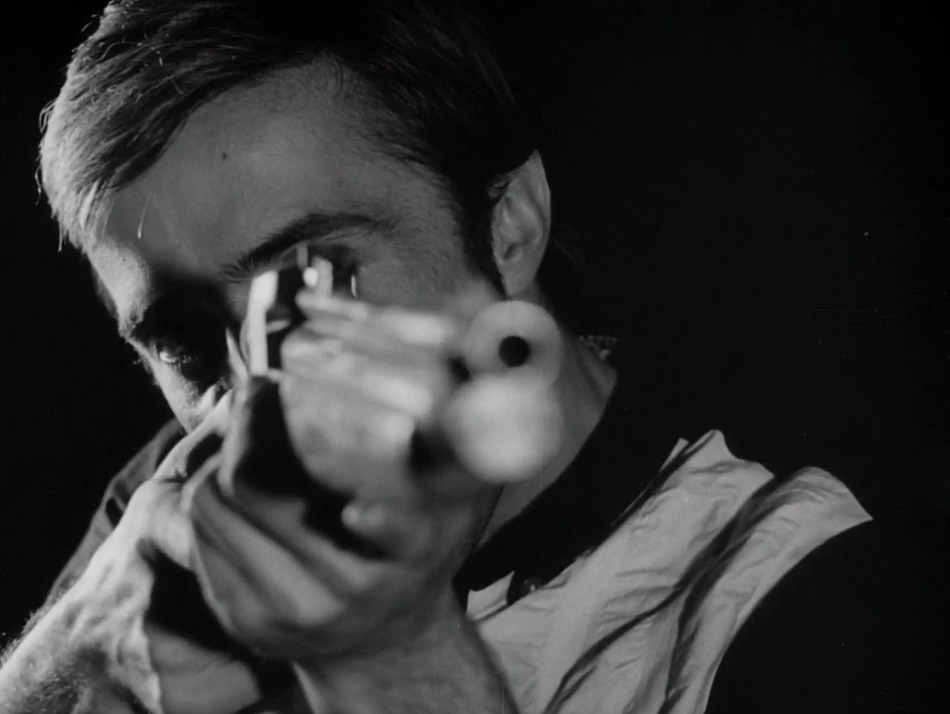OUTLAW CINEMA (CINEMA FORA DA LEI)
Manifesto by Rogério Sganzerla (written in 1968, during the shooting of The Red Light Bandit), translation courtesy of Trixi.
Manifesto by Rogério Sganzerla (written in 1968, during the shooting of The Red Light Bandit), translation courtesy of Trixi.

1 - My film is a western about the Third World. That is, a fusion and blending of various genres. I made a filme-soma¹; a western, but also a musical, a documentary, a detective film, a comedy (or chanchada?²) and science fiction. From documentary, the sincerity (Rossellini); from detective, the violence (Fuller); from comedy, the anarchic rhythm (Sennett, Keaton); from western, the brutal simplification of conflicts (Mann).
₁ - “a film-sum”, being a movie made up from additions of these other genres. ₂ - Brazilian genre of musical comedies made mainly between the 1930s and 1950s.
2 - The Red Light Bandit pursues the police, while the cops make metaphysical reflections, contemplating loneliness and incommunicability. When a character can't do anything, he screws it up.
3 - Orson Welles taught me not to separate politics from crime.
4 - Jean-Luc Godard taught me to film everything for half the price.
5 - In Glauber Rocha I became familiar with a guerrilla cinema based on wide shots.
6 - Fuller was the one who taught me how to dismantle traditional cinema through montage.
7 - Filmmaker of excess and crime, José Mojica Marins introduced me to the furious poetry of the actors from Brás³, to the obscene curtains and ruins and their apparently banal dialogues. Mojica and the cinema of Japan taught me how to be free and - at the same time - academic.
₃ - In 1964, Mojica set up a synagogue in the Brás neighborhood where he experimented with amateur actors and tested their courage and talent.
8 - The solitary Murnau taught me to love the static shot above all travellings.
9 - It's necessary to discover the secret of the cinema of Luis, poet and agitator Buñuel, exterminating angel.
10 - Never forgetting Hitchcock, Eisenstein and Nicholas Ray.
11 - Because what I really wanted was to make a magical, obscene movie whose characters were sublime and stupid, where stupidity - above all else - revealed the secret laws of the underdeveloped soul and body. I wanted to make a picture about a delirious society, threatened by a solitary criminal. I wanted to make this leap because I understood that I had to film the possible and the impossible in an underdeveloped country. My characters are, all of them, uselessly stupid - in fact, like 80% of Brazilian cinema; from the tragic stupidity of Corisco⁴ to the nonsense of Boca de Ouro⁵, passing through Coffin Joe⁶ and the pariahs of Barravento⁷.
₄ - Character (based on the real figure) from the 1964 film “Black God, White Devil”, directed by Glauber Rocha. ₅ - 1963 film directed by Nelson Pereira dos Santos. ₆ - Character played by José Mojica Marins in his own films. ₇ - 1962 film directed by Glauber Rocha.
12 - I'm filming the life of The Red Light Bandit⁸ just as I could be retelling the miracles of St. John the Baptist, the youth of Marx or the adventures of Chateaubriand. It's a good pretext to reflect on Brazil in the decade of the 1960s. In this scenario, politics and crime identify characters from the upper and lower world.
₈ - The Red Light Bandit, as well as being the main character of the movie, was also an actual criminal and one of Brazil's most notorious criminal cases.
13 - I had to make this outlaw cinema here in São Paulo because I wanted to make a total effort towards the liberating Brazilian film, revolutionary also in its panoramic shots, fixed camera and dry cuts. The starting point for our films must be the instability of cinema - as well as of our society, our aesthetics, our loves and our sleep. That's why the camera is indecisive; the sound fleeting; the characters frightened. In this country, everything is possible and that's why the movie could explode at any moment.
Revista Cavalo Azul, 1968 [Republished in the catalogue for Ocupação Rogério Sganzerla, 2010]